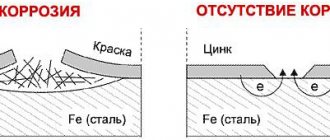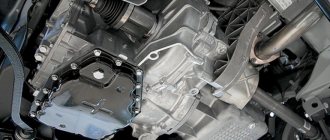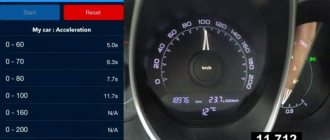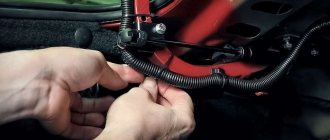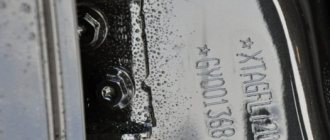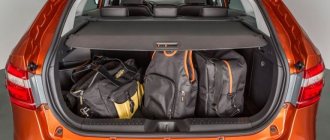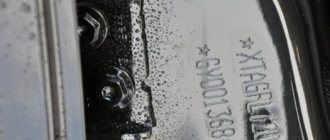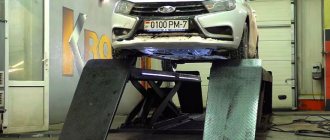A new car always raises many questions. Especially if it is widely advertised. And what’s more, the manufacturer didn’t skimp on advertising the LADA Vesta.
Naturally, the new product was discussed on social networks. And what’s nice, with the participation of representatives of AVTOVAZ. It was on Facebook that the first question about the corrosion resistance of the car was asked. And this is what the plant responded through the mouth of its marketing service:
“There are four days left before the start of serial production of LADA Vesta. In the comments we were asked how corrosion resistant the body of the new car would be. We answer.
LADA Vesta's front body parts are made of high-quality double-sided hot-dip galvanized rolled steel of domestic production.
In addition, in order to increase the degree of protection against corrosion, a modern complex of paints and varnishes was used. The use of a new generation of cataphoresis primer can significantly enhance the anti-corrosion protection of the body. Polyester primer provides increased resistance to chipping from impacts from stones and gravel. The new topcoat has improved UV resistance, scratch and machine wash resistance and acid resistance.
The tightness of the body has been improved through the use of new technologies and materials for processing welds used in cars of the Renault-Nissan Alliance.
For additional anti-corrosion protection of the internal hidden cavities of the body, new technology and a protective wax-oil composition are used. Its advantages are the ability to penetrate deeply into flange connections, providing high-quality corrosion protection throughout the entire service life. An important factor is that it does not contain an organic solvent. This makes it possible to significantly reduce its emissions into the atmosphere and improve the environmental performance of production.
The LADA Vesta is also equipped with anti-corrosion technology for chassis parts. The underbody of the car body is treated with an anti-corrosion compound with high protective properties, forming a film that is resistant to moisture and temperatures characteristic of the climatic zones of the Russian Federation. All this provides reliable protection of the car from corrosion.”
Detailed and reassuring explanation from the manufacturer. Very good. But this does not mean that the consumer can rejoice and safely drive a new car. We know how dangerous and insidious corrosion is. And on January 11, 2016, Test-drive TV journalists published a video on this topic on the Internet. And exactly according to LADA Vesta.
Here is the link https://www.youtube.com/watch?v=K3KUjmLLCxE. And here is the authors’ preface to their small but very rich and informative work:
“Our viewers were interested in how the LADA Vesta was doing with corrosion. Some asked directly: where will “Vesta” begin to rust? To find the answer to this question and evaluate the factory protection of LADA Vesta from corrosion, we turned to anti-corrosion treatment specialists.”
Well, as they say, let's stock up on popcorn and watch.
Here is a brand new Vesta driving onto a lift and rising above the floor (photo 1). It is washed thoroughly - without this, body diagnostics are impossible.
An expert appears on the screen - director of the Krown anti-corrosion treatment center Sergey Mukhlaev (photo 2). Noting with satisfaction that the engine has standard crankcase protection, Sergey proceeds to inspect the bottom.
On the bottom we see soft mastic, partially applied to critical, from the plant’s point of view, areas. Moreover, it was applied in small spots and in a very thin layer (photos 3 and 4). For daily use this is completely insufficient - additional processing is required.
The body has quite a lot of hidden cavities. And various overlaps and “pockets” at the junctions of body panels. Moisture will get into them. And accumulate there.
True, the plant recognizes these areas as problematic and treats them with a preparation reminiscent of Movil. The streaks of this material are clearly visible (photos 5 and 6). But its quantity is clearly not enough. And in welded joints, the expert finds many gaps where moisture will also accumulate. Corrosion is guaranteed in the near future. Therefore, after purchasing a car, all these areas also need to be carefully processed.
But the open flat fragments of the bottom are well protected by the factory. If there is no mechanical damage, their coating will last quite a long time (photo 7). However, Sergei emphasizes once again, all other areas of the bottom must be protected additionally - there are too many traps for moisture, snow, and ice.
Next, the expert points to the air conditioner breather located on the bottom. Around it we see traces of additional anti-corrosion treatment - a thin layer of sticky mastic (photo 8). This was not done by a machine gun on a conveyor belt, Sergei clarifies, but by a worker using a spray gun.
As it was before
For many years, Zhigulis were primed using long-outdated technology, by anaphoresis treatment or anodic deposition. Moreover, even at the time Fiat built the plant in Togliatti, it was not the most modern, but the Italians did not sell their latest developments. And until 1978, they used imported components, until the USSR learned to make the necessary chemical compositions on their own.
Over time, the plant made a big breakthrough in this area. New equipment was purchased; instead of ordinary metal (only with primer), they began to use galvanized metal. In particular, as stated, on the “ten” (VAZ-2110) the number of such body elements is 30-50%, depending on the year of manufacture. For Priora and Kalina, this percentage reaches 70.
Since 1988, VAZ began to paint bodies, including metallic ones. Previously, this option was not available.
One way or another, the opinion has become firmly established among car enthusiasts that VAZs definitely need to be additionally “anti-bark,” that is, the body must be treated in addition to the factory one. Otherwise, even with careful use, the car will become covered with unpleasant red spots, and then completely rot very quickly. This especially applies to Moscow, where in winter a huge amount of chemical reagents are poured onto the streets, which, in addition to their direct task (fighting asphalt icing), literally corrode automobile metal.
What can you do to prevent measles?
Some people order the necessary operation at a service station (official, universal, or even a garage), other owners of Lada cars do not trust the craftsmen and prefer to do everything themselves, thus saving money on paying for the work - after all, you only need to purchase materials.
You will find an overview of the characteristics and features of the Singulato iS6 Electric SUV here.
The most common compositions:
- various types of Movils. There are a huge number of manufacturers, even the verb “zamovilit” (process with Movil) has appeared;
- Body mastics. The number indicates the differences in the specific composition;
- cannon lard (an inexpensive and extremely popular petroleum-based lubricant that has water-repellent and preservative properties).
As for frequency, this is up to the owner of the car. Some people are not lazy to go over the body once a year, others process it every two or three years, or even less often.
You will find the test results of various anticorrosives in this video:
Inspection of the bottom of Lada Vesta 2022
Hello everyone!
So, I bought myself a new Russian car LADA Vesta SV Cross and naturally I was interested in how it was assembled (I am a technician by trade, I am interested in technical solutions used in cars), I decided to start the inspection from the bottom, for which I drove the Vesta SV Cross to the nearest overpass...
First of all, I appreciated the anti-corrosion treatment that the dealer gave as a gift. Nothing, they blew it out quite tolerably, although the car already came from the factory with a thick standard white anti-gravel protection that covers the arches and the entire bottom of the Vesta. Well, okay, it won’t be superfluous, it’s free)
All fender liners turned out to be made of soft fiber material, which should reduce noise from the arches, especially on a primer. Let's see if this becomes a problem in the winter when there is a thaw, when wet and sticky snow likes to accumulate in the wheel arches and interfere with the operation of the suspension...
A very strong advantage of the car immediately caught my eye - it is an absolutely flat bottom without protruding parts, creating an honest ground clearance of as much as 203 mm! That's more than many crossovers! For Russian realities this is a clear plus. The engine and gearbox are protected by a large metal boot, which, if something happens, can also have some protective function.
An examination of the suspension elements confirmed that the Vesta SV Cross is based on the VAZ LADA-B platform, as the stickers on the suspension elements directly indicate. The front has a simple, sledgehammer-like MacPherson strut; the rear, suspiciously reminiscent of a Meganovskaya, has a semi-independent torsion beam. This platform originates from the Lada-S project, which died out in 2009. The 1.8 liter engine also originates from that “frozen” project.
Well, well, Vesta’s platform was quite a success! Handling and behavior on the road are a solid A for a car of this class. This is greatly facilitated by the fact that the front part of the car is assembled on a subframe, as if as a single unit, which allows very precise positioning of the front suspension elements, hence the handling, hence the stability of quality.
Painting Lada Vesta
Painting of the car begins after the application of primer has been completed. Step by step, the car is prepared for the painting procedure. Since painting is done with an aerosol in several layers, robot labor is used. A solution is applied to the surface, strengthening the seams and protecting the body from corrosion. Then noise-insulating mastic is used, which adds silence to the car on the roads.
When applying primer coating with robots, many hard-to-reach places remain and have to be processed manually. The inner sides of the pillars, the edges of the roof covered with doors, are finished manually. The primer comes in two tones: light or dark. Choose depending on the color of the car.
Once the priming stages are completed, the car is sent to the next conveyor for developing the secondary layer. Here, specialists eliminate paint coating application defects and coat the seams with brushes and paste. After all the procedures, specialists, with the help of robots, proceed directly to painting the car. The paint application process is not complicated. A common aerosol spray that motorists have dealt with. A layer of varnish is applied over the paint, and the finished painted and varnished body is sent to dry, which takes an hour. The entire painting procedure lasts no more than four hours.
When the body is dried and the varnish is applied, there are a few final steps left, after which we get the product in the form in which it ends up on the market. The final touches are polishing and applying anti-corrosion. The result is a durable, galvanized body of the Lada Vesta. Let us remind you that the thickness of the car’s paintwork is higher than that of other parts of the car, which makes it reliable and resistant to changing weather conditions.
How to protect Lada Vesta from rust
Anti-corrosion treatment extends the service life of the vehicle. This work is carried out as the protective mastic wears out. Corrosion manifests itself faster due to unfavorable climatic conditions and low-quality cheap protection materials. A rusty Lada Vesta can be restored using special protective compounds.
Additional factory anti-corrosion treatment
AvtoVAZ, in the interests of customers, applies additional corrosion protection. Factory processing locations:
- cavity near the scutes;
- the space between the shock absorber mount and the wheel arch;
- hidden space near the side members;
- cavity behind the sidewall trim;
- junction of the sill trim;
- cavity in the floor under the rear seat;
- luggage lid panels;
- cavities in door openings;
- hood panels.
In addition to the indicated places, the factory additionally processes body fasteners, holes and surface joints.
Processing in a car service
Good quality anti-corrosion protection can be provided by specialists involved in maintenance of Lada Vesta Cross, SW and sedan. Before treatment, the exterior and hidden cavities of the vehicle are thoroughly washed to remove dirt. Dry the car until moisture is completely removed from the surface.
Fret processing. Photo source: 37autoservis.ru
Procedure for applying anti-corrosion protection:
- Installing the car on a lift.
- Dismantling of plastic linings and protective aprons, seals.
- Dismantling the trunk trim, cleaning the cavity with a vacuum cleaner from debris and dirt.
- Cleaning rotten areas of the body. Treatment with primary anti-corrosion primer.
- Placing the car in a special chamber for spraying anticorrosive. Removing wheels. Installing covers on drive mechanisms, hoses and electrical wiring harnesses.
- Spraying an anti-corrosion agent onto the surface. Treatment of hidden cavities with a spray gun according to the manual scheme.
- Cleaning fresh compound from paintwork and plastic parts. Assembly of wheels, protective linings and seals.
- Dry the composition for 3-5 hours at room temperature.
When the protection dries, the car must not be moved. The thickness of the layer of applied composition is checked with a thickness gauge.
Do-it-yourself Vesta protection from corrosion
The car usually does not need additional rust treatment for the first 3 years. But it is better to check the condition of the coating annually. Protective compounds for metal surfaces:
- Underbody materials with gravel protection function. The composition must contain inhibitors and have noise-absorbing properties. Bitumen mastic with filler is suitable for this.
- The anti-corrosion composition of the wheel arch coating must be resistant to abrasive wear of the surface. A “liquid locker” or applying bitumen mastic in 2-3 layers is suitable for processing.
- Treatment of hidden cavities is carried out with liquid anticorrosive agent. The composition effectively displaces moisture and forms a dense film on the metal.
The use of high-quality compounds will protect the car from rust for 2-3 years.
Choice of anticorrosive: compositions and prices
There are a lot of rust protection methods - from simple products to expensive imported mastics:
- Anticorrosive on Vesta is prepared with your own hands from “Gun Lard” and “Cordon” mastic. The total cost of the mixture is about 400 rubles per 1 kg. The product is applied to the surface with a brush.
- The product “Reduced lead ship” covers the surface with an oxide film. Price – 400 rubles per jar.
- Universal “Glue 88” is applied to a degreased surface. The water-repellent film reliably protects metal parts. The cost of glue is up to 400 rubles per package.
- Dinitrol sealant contains inhibitors and anti-gravel additives. Mastic has noise insulating properties. Packaging price – 1150 rubles.
- Anticorrosive Hi Gear contains rubber filler and additives that neutralize road reagents. Cost up to 400 rubles.
- The protective coating "Noksidol" is universal, also suitable for treating hidden cavities. The price of the package is about 700 rubles.
- LIQUI MOLY anti-corrosion agent is used even for old cars. Double application of mastic reliably protects against rust. The cost of the can is less than 500 rubles.
- Liquid Supra Shield easily penetrates into hidden cavities, displaces water and forms a durable protective film. The price of anticorrosive agent is low - 200 rubles per liter.
When choosing protection, it is necessary, in addition to the cost of the product, to take into account the condition of the surface.
How the new Lada Vesta is protected from corrosion
The car body is made of galvanized steel. A cataphoresis primer is applied under the paint layer. The coating is resistant to mechanical stress. The cavities and recesses are treated with an oil-wax composition to prevent corrosion. The bottom and chassis elements are coated with a product that is resistant to humidity and temperature changes.
Checking Vesta for corrosion. Photo source: pikabu.ru
But Lada Vesta has problem areas that require corrosion treatment:
- Too thin a layer of mastic on the bottom, uneven application.
- The gaps at the joints of the body parts were treated with Movil with smudges, unevenly.
- Poor treatment with the compound in the area where the air conditioner breather exits.
- There is no anti-corrosion treatment at the junction of the trunk and rear side member.
- The rear arches do not have lockers, moisture and dirt accumulate on the metal surface.
- The plastic does not fit tightly to the front fender, allowing water to enter the cavity.
- There is no anticorrosive in the upper part of the hood, as well as on the lock.
- The door seal closes the drainage holes, moisture accumulates on the thresholds.
- A very thin layer of protective mastic in the trunk cavities.
The car's protection is no worse than that of its competitors. But it is advisable to additionally treat critical surfaces of the Lada Vesta with an anti-corrosion compound.
The procedure for anti-corrosion treatment of Vesta with your own hands
The cost of proprietary anticorrosive treatment ranges from 5 to 15 thousand rubles. If you apply the anti-corrosion compound yourself, you can save money. You will need a plastic anti-corrosion agent for the bottom of the car, protecting the protruding parts, a spray and a liquid composition for treating cavities.
Anticorrosive agents. Photo source: drive2.ru
Work order:
- Rinse the surface to be treated well. Remove any remaining worn coating.
- Dry the surface with compressed air or a hairdryer for 30 minutes.
- Inspect for cracks and rust spots. Eliminate defects and clean workpieces.
- Apply anti-corrosion protection to the bottom of the Vesta with a brush, and to other surfaces by spraying it with a spray. The thickness of the layer on the bottom must be at least 0.25 mm.
- Dry the anticorrosive for 24 hours. Do not operate the machine at this time.
It is a mistake to assume that the manufacturer has made ideal rust protection. Corrosion of the Lada Vesta can manifest itself in poorly treated hidden cavities. Regular checks of the condition of the coating and additional anti-corrosion treatment at home or at a service station are required. Reviews on the forum of Lada West owners confirm this.
Mikhail: “After a year of operation, the Lada Vesta Cross discovered small spots of rust on the exhaust pipe. The rest of the surfaces are fine. I think that the anti-corrosion protection has been done satisfactorily.”
Vladimir: “I was unpleasantly surprised by the rust on the front side members of the Lada Vesta SV after 10 months. operation. I think the reason is poor quality anti-corrosion treatment at the factory.”
Comments from Lada Vesta owners will help you navigate when doing rust removal yourself.
New era
The arrival of the French from Renault marked the beginning of a new century at VAZ. A lot of things have been and will be done, but the main thing that buyers have seen now are two new models - Vesta and X-RAY on “mother” platforms. The cars look very stylish, bright and modern - better than many competitors.
The designers did a great job. Of course, the interest of potential clients was and is very high. Photo: lada-vesta2.ru
One of the many questions that many people ask concerns the protection of metal from rust. Say, if Ladas are now quite comparable in price to budget foreign cars assembled in Russia, then perhaps the quality of bodywork right at the factory has increased? Maybe now you don’t need to carry out additional processing every few years, spending time and money on it? Much the same as what happens with a co-platform Renault Logan or any similar car. And if something happens, there is a guarantee against through corrosion.
Do Lada Vesta and Lada X-RAY rust: about the anti-corrosion resistance of domestic new products
For several decades, Lada cars have consistently ranked first in sales rankings in our country. Cars with a rook on a false radiator grille are well known and loved not only in Russia, but also far beyond its borders. Simplicity of design, amazing maintainability, widespread availability of spare parts and low prices are the main competitive advantages of this brand. But these have many disadvantages, one of which is the high probability of body corrosion. Let's see how the situation with corrosion is in the new Lada models.
There is one consumer quality for which Ladas could never be praised. This is the corrosion resistance of the body. Photo: olade.ru
Does Lada Vesta need additional anti-corrosion treatment?
Above, we have already examined the strengths of paintwork and the presence of galvanization. To answer more precisely, you need to understand what the car body is made of. Low carbon sheet steel is a component that makes up the body. Steel is prone to corrosion. If we add that the body is not completely galvanized, but is protected only from the outside, the conclusion suggests itself - factory galvanization is not enough.
During one of the test drives conducted by Russian auto experts in the first months after the release of Vesta, it was noticed that the inside of the car and especially the bottom were galvanized somehow. The car is well made, but if you look deeper, you can feel the manufacturer’s signature. There are several types of application of additional primer, which are used depending on the primary galvanizing method.
The main places where rust appears on Vesta
Owners of Lada Vesta usually pay attention to the external manifestation of corrosion. But there are many hidden cavities and passages in the car where rust can appear. Standard processing does not last forever and requires periodic updating. The underside of the vehicle is subject to wear and tear due to ingress of solid particles. Additionally, reagents together with moisture can accelerate corrosion.
Corrosion on Vesta. Photo source: olade.ru
Surfaces where Lada Vesta rots:
- hidden body niches;
- uneven welds;
- ceiling steel panels;
- drainage holes;
- gaps under plastic linings;
- areas of body paint damage.
The state of protection of external parts can be assessed visually. A borescope is used to check the general condition of the cavity lining. To inspect the anti-corrosion coating, an ultrasonic thickness gauge is used, or, less commonly, a spark flaw detector.
Is the body of the Lada Vesta galvanized?
The manufacturer claims that the body of this car is completely galvanized. For example, a crossover like the X-Ray does not have a galvanized roof, but Vesta supposedly has all its parts galvanized. But it’s too early for the owners of this car to rejoice. As it turned out, when treating the body with zinc, AvtoVAZ uses the cheapest and worst of all available technologies. In addition, the metal is coated with zinc only on the outer side, while the inner surface is treated in a different way - cataphoresis.
Currently, there are three technologies for galvanizing metal:
- Hot. With it, the entire fully assembled body is dipped into a special bath filled with zinc. Well-known brands such as Porsche and Volvo use this method.
- Galvanic. The metal is in an acidic environment with electrolytes. A body protected by this method will not only be protected from corrosion, but also from electromagnetic radiation. This method of processing in the manufacture of cars has been adopted by brands such as BMW, Toyota, Mercedes and others.
- Cold. A mixture containing zinc is applied to the surface of the body using a sprayer, similar to car enamel.
The third option allows you to choose which side of the metal will be coated with zinc. In addition, it is also the cheapest, which is what AvtoVAZ and the Izhevsk plant, where Vesta sedans are assembled, use. Thus, the entire outer surface of the body is coated with zinc.
Is galvanizing alone sufficient for corrosion protection?
Any body, including Vesta, has hidden cavities that are obtained after assembly. If they are left unprotected, the car will not last long. To extend the life of parts, they are coated with a special primer. This technology is called cataphoresis. Just like galvanizing, cataphoresis treatment significantly increases the metal's resistance to rust.
In addition to protecting the body, the manufacturer took care of all other elements of the car. Arches, sills and bottom are treated with anti-gravel, which forms a protective film that is resistant to temperature changes and moisture.
It would seem that everything is good and beautiful. This is exactly what AvtoVAZ representatives themselves say, and there is probably no need for additional anti-corrosion protection for the Lada Vesta. How does everything look after examination by an independent expert? He saw that the engine had good factory protection and that additional protection would no longer be required.
Is it necessary to apply anti-corrosion protection to Lada Vesta body parts?
Next, the expert saw partially applied viscous mastic in places that the manufacturer considered the most critical. Its layer is very thin, and for greater reliability, Vesta will definitely need additional anticorrosive in these places. The body design of this car is such that there are many parts with corners, as well as hidden cavities. They will easily collect moisture, so treating such areas will significantly extend their service life.
Perhaps, only the open parts of the car are well protected (but not from severe mechanical damage), but the rest require mandatory anti-corrosive treatment. As they said at the factory, a large number of different pockets, which are countless on the body, are treated with some kind of product that is very reminiscent of Movil. Everything is fine here, but for some reason the welded seams, which collect moisture and are the first to become corroded, are not protected.
This is why owners of new Lada Vesta and XRAY cars should worry about body rust.
It would seem that everything possible has been written about the new Lada cars – Vesta and XRAY. But nevertheless, every day more and more questions about these cars appear on the Internet, both from those who still want to buy a new Lada, and from those who have already become the proud owner of a new domestic car. What do you think interests car enthusiasts most about the new Ladas? Especially in the new Lada Vesta. Do new cars rot quickly? After all, the main problem of our automobile industry has always been associated primarily with rapid corrosion of the body. It is not surprising that many people are concerned about whether the bodies of new AvtoVAZ cars meet modern corrosion protection standards. We'll talk about this today.
So do new Ladas rot or not? To find out, the Lada Online portal recently conducted a survey among owners of Lada Vesta and Lada XRAY whether they were satisfied with the level of anti-corrosion treatment of the body of new domestic cars.
As the survey showed, owners of new Lada cars quite often complain about the appearance of signs of rust in new cars. Most often, according to a survey by the Lada Online website, car owners find signs of corrosion on the exhaust system and suspension parts, which, of course, is not so scary, since this does not apply to body elements. But what is most worrying is the feedback from the owners of new Zhiguli cars, who claim that rust often appears on the welds of the body. In particular, some owners report that the internal cavities of the body of the Lada Vesta and Lada XRAY do not have very good anti-corrosion treatment of the body.
By the way, some auto experts also report this. In addition, experts and critics have questions about the design of some body parts, which, in their opinion, were designed with errors. For example, there are many cavities on the body where water constantly collects. This means that rust can appear quite quickly in these areas.

